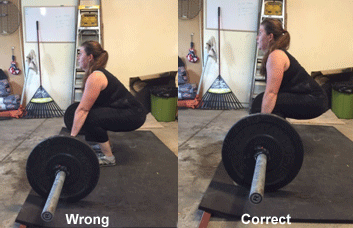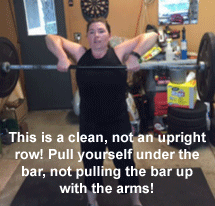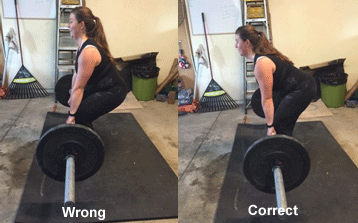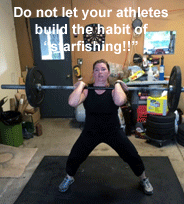If you work with an athletic population, odds are you will see athletes that
either are Olympic weightlifters as their primary sport, or utilize the moves to
help build power and strength to improve at their given sport. When we see
athletic patients after an injury, it is important that we are able to rehab
patient to prior level of function, and this includes performing the Olympic
lifts in their training program. In this article I will highlight some of the
most often seen mistakes during the full clean and power clean exercise, and
simple cues to help correct them.
Knees not “through elbows”
A very simple cue for the athlete to obtain a proper starting position is to
make sure that their knees are “through the elbows.” This position makes sure
there isn’t excessive forward lean, the weight is not too far anterior during
the pulling phase, and allows for complete and proper power transfer from the
lower extremities into the floor.

Transferring weight to the toes during the pull
If the athletes starting position is correct, this often
isn’t an issue. As the athlete begins to pull through the
phases of the clean, it important that the weight stays
distributed across the bottom of the foot and more toward
the heel. Should the weight transfer to the toes prior to
the very end of full extension, it is now too far anterior,
and will shift the majority of force production off the hip
extensors and onto anterior musculature. This will likely
result in the weight translating anterior from the body,
forcing the athlete to jump forward to catch, or a missed
catch, and overall will decrease the power production.
Simple cuing for proper “knees through elbows” and neutral
spine positioning at start position will help eliminate this
problem.
Letting the bar move away from the body
A common mistake seen is to let the bar path drift forward,
away from the body. This decreases the power of the pull and
sets up for the athlete to have to hop forward to get under
the bar, and often a missed catch. Cuing the athlete to
“keep the bar close,” “brush the body,” and “activate the
latissimus” during the lift will encourage keep the bar
track close to the body and help decrease anterior
translation.
Premature bending of elbows
 Always remember that the power of the Olympic lifts is developed from the
hips and lower extremities. Many athletes will try to pull the bar upward, like
an upright row, rather developing the extension through the hips. The arms are
merely a connection of the trunk to the bar. A great analogy I was told was to
think of the arms as chains attached to the bar. If the athlete begins bending
the elbows and trying to pull the bar up with their arms, they have lost the
ability to translate the force of the hip extension to the bar. Cueing the
athlete to think of the arms as chains and “pull themselves under the bar”
rather than pulling the bar up will help fix the issue.
Always remember that the power of the Olympic lifts is developed from the
hips and lower extremities. Many athletes will try to pull the bar upward, like
an upright row, rather developing the extension through the hips. The arms are
merely a connection of the trunk to the bar. A great analogy I was told was to
think of the arms as chains attached to the bar. If the athlete begins bending
the elbows and trying to pull the bar up with their arms, they have lost the
ability to translate the force of the hip extension to the bar. Cueing the
athlete to think of the arms as chains and “pull themselves under the bar”
rather than pulling the bar up will help fix the issue.
Opening hips too soon
During the first pull of the clean, the angle of the hips
and trunk should stay approximately the same as the athlete
extends the knees. The point of the first pull in to begin
developing power and position the bar optimally for a
forceful hip extension from the power position. We commonly
see athletes beginning to extend and open the hips prior to
the power position and this will decrease force production.
Cueing the athlete to maintain the same degree of hip
flexion and angle of the trunk in relationship to the floor
will help fix the issue.

“Starfishing”
 This
is one of the most often seen errors and one that could be
potentially injurious to the lower extremity. “Starfishing”
is when the athlete abducts into a foot spread position to
get under the bar for the catch rather than flexing at the
knees and hips as they should. This position applies
significant stress to the knee, especially as the load of
the lift increases. Making sure to cue the athlete to “get
under the bar,” working on just the catch portion of the
lift, and including front squats as a supplemental lift to
groove the pattern and build the strength necessary for the
proper position will help decrease this tendency.
This
is one of the most often seen errors and one that could be
potentially injurious to the lower extremity. “Starfishing”
is when the athlete abducts into a foot spread position to
get under the bar for the catch rather than flexing at the
knees and hips as they should. This position applies
significant stress to the knee, especially as the load of
the lift increases. Making sure to cue the athlete to “get
under the bar,” working on just the catch portion of the
lift, and including front squats as a supplemental lift to
groove the pattern and build the strength necessary for the
proper position will help decrease this tendency.
A few simple cues to your athletes can help
clean up some common mistakes seen during the clean. Proper
form will decrease improper stresses to the joints and
muscles and provide for return to regular training program
and return to sport. If your patient requires more training
on the Olympic lifts and you are not comfortable or properly
educated on the execution and coaching of them, make sure to
refer out to a sports PT, ATC, or Olympic lifting/strength
coach that is!
Last revised: June 21, 2015
by Bill Lyon, PT, DPT, CSCS, USAW-L1



 Always remember that the power of the Olympic lifts is developed from the
hips and lower extremities. Many athletes will try to pull the bar upward, like
an upright row, rather developing the extension through the hips. The arms are
merely a connection of the trunk to the bar. A great analogy I was told was to
think of the arms as chains attached to the bar. If the athlete begins bending
the elbows and trying to pull the bar up with their arms, they have lost the
ability to translate the force of the hip extension to the bar. Cueing the
athlete to think of the arms as chains and “pull themselves under the bar”
rather than pulling the bar up will help fix the issue.
Always remember that the power of the Olympic lifts is developed from the
hips and lower extremities. Many athletes will try to pull the bar upward, like
an upright row, rather developing the extension through the hips. The arms are
merely a connection of the trunk to the bar. A great analogy I was told was to
think of the arms as chains attached to the bar. If the athlete begins bending
the elbows and trying to pull the bar up with their arms, they have lost the
ability to translate the force of the hip extension to the bar. Cueing the
athlete to think of the arms as chains and “pull themselves under the bar”
rather than pulling the bar up will help fix the issue.
 This
is one of the most often seen errors and one that could be
potentially injurious to the lower extremity. “Starfishing”
is when the athlete abducts into a foot spread position to
get under the bar for the catch rather than flexing at the
knees and hips as they should. This position applies
significant stress to the knee, especially as the load of
the lift increases. Making sure to cue the athlete to “get
under the bar,” working on just the catch portion of the
lift, and including front squats as a supplemental lift to
groove the pattern and build the strength necessary for the
proper position will help decrease this tendency.
This
is one of the most often seen errors and one that could be
potentially injurious to the lower extremity. “Starfishing”
is when the athlete abducts into a foot spread position to
get under the bar for the catch rather than flexing at the
knees and hips as they should. This position applies
significant stress to the knee, especially as the load of
the lift increases. Making sure to cue the athlete to “get
under the bar,” working on just the catch portion of the
lift, and including front squats as a supplemental lift to
groove the pattern and build the strength necessary for the
proper position will help decrease this tendency.



